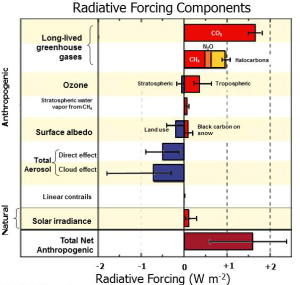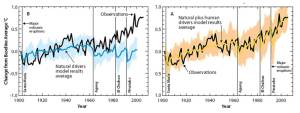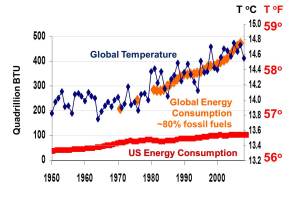Evidence for Human Contribution
Evidence is strong that human activities are the dominant cause of global warming. We have long known that as greenhouse gases, like CO2, increase in the atmosphere, the atmosphere warms by trapping heat energy radiating from the Earth to space. Other natural forces also cause warming or cooling, like changes in the sun’s radiation (warming or cooling) and volcanic eruptions (cooling in the short-term, warming in the long-term). So what is the evidence that humans are the cause? The primary evidence is listed and described in more detail below:
- Measurements of human caused effects vs natural effects shows that human effects are the predominant causes.
- Natural changes alone do not account for the changes we’ve seen. We need to add human causes to match observed data.
- Isotope “fingerprints” identify the additional CO2 in the atmosphere as coming from burning of fossil fuels.
- Observed shifts in the boundary between the troposphere (lower atmosphere) and stratosphere (higher atmosphere) would not occur if solar radiance was the sole driver of warming.
- We have burned more than enough fossil fuels to account for the increase in CO2 concentration in the atmosphere.
Radiative Forcing
Scientists can measure the amount by which solar irradiance, dust and tiny airborne particles (called aerosols), greenhouse gases and other effects cause either warming or cooling. This effect is measured in watts per square meter (a watt is about the same as a tiny Christmas tree light). If the radiative forcing is positive, it causes warming; if negative, it causes cooling. The Intergovernmental Panel on Climate Change 2007 report showed their compilation of radiative forcing components.
Figure from IPCC 2007 report. Click on figure to enlarge. 
Values to the right of zero warm the planet; values to the left cool. Capped horizontal lines indicate uncertainties. Aerosols cause a direct effect, like reflection from light-colored particles of smoke or other particulates, and a cloud effect — particles serve as nuclei for water droplets to form clouds. Both light-colored particulates and clouds shade the Earth and cause cooling. Black particles of soot absorb energy and cause warming.
Note that heating from solar irradiance is small relative to human caused (anthropogenic) factors. Note also that the cooling effects of aerosols — many of which are formed of pollutants from burning of fossil fuels — nearly counterbalances the warming effects of greenhouse gases, although the uncertainties of the aerosol effects are large. Aerosol pollutants typically remain in the atmosphere for days to years, while the greenhouse gases stay in the atmosphere for decades to centuries. Halocarbons or chlorofluorocarbons (CFCs) can remain in the atmosphere for thousands of years. Water vapor is an important greenhouse gas but is not shown because it has very short atmospheric life (days) and its concentration depends strongly on the temperatures in the atmosphere and on the ocean surface. It acts to amplify the effects of the other greenhouse gases.
See more explanation on radiative forcing here.
Natural Changes Alone Don’t Account for Observed Data
The IPCC modeled what we would expect if we used only natural drivers to explain the observed, measured temperatures. 
As seen in the figure, their models show that natural drivers alone do not match observed data (plot on the left). But if we include anthropogenic factors, the models match the data well (plot on the right). Similar results were seen when only ocean temperatures were modeled. Click on figure to enlarge.
Figure after UCS, original from IPCC 2007. Click on figure to enlarge.
Isotopic Data
The carbon that comes from burning of fossil fuels is isotopically different from the combined signal of those from other sources. The proportion of the three principal isotopes of carbon, C12, C13, and C14 vary depending on how the carbon was derived. Did the carbon come from modern plants? fossil plants? decay? Isotopes can tell us. For example, the C14 carbon isotope is radioactive and dies away to nearly zero in about 50,000 years. Since fossil fuels are much older than that they show no C14. Adding carbon from burning of fossil fuels should lower the proportion of C14 in the atmosphere, which is what we do see. Read more on isotopic evidence here.
Expanding Lower Atmosphere
The boundary between the lower atmosphere (troposphere) and the higher atmosphere (stratosphere) has shifted upward in recent decades, and the stratosphere has cooled. Why is this? Heat-trapping gases accumulate in the lower atmosphere which causes it to heat and expand, shifting the boundary upward. Further, because less heat is escaping into the higher atmosphere, the higher atmosphere is cooling. This not what we would see if the sun was the sole driver. Solar irradiance would warm both layers, certainly not just the lower while cooling the upper.
See additional information on the topic of human contribution to climate change from NASA and the Union of Concerned Scientists.
Correlation of Global Energy Consumption and Temperature
Although a correlation is not proof, it is compelling. As shown in the figure, at least since the mid 1970s, as global energy consumption increased, global temperature increased.
Click on figure to enlarge.
Temperature data from NASA, Energy consumption data from DOE.
